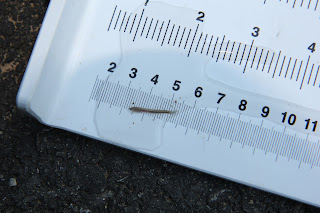During this summer I have been working under two grants (one through the Sussman Foundation and the other through the Hudson River Foundation). Both grants are interested in identifying the location of sea lamprey in the Hudson River and the capture of ammocoetes as vouchers for further research. However, the Polgar fellowship also includes a stable isotope component. I will need to write a separate entry to describe stable isotopes for those interested but we returned to Lowland Town Park to collect our samples for that portion of the fellowship. Last time we were in the park (July) we did not see any young of year lamprey (we arrived too soon) but we did find lots of them this time!
We also collected numerous stable isotope samples for analysis this fall when we return and process them at the lab first. Here is a picture of me returning with a terrestrial soil surface sample which we plan to analyze.
This creek is generally in very good condition with very complex habitat and large areas for the stream to meander. Streams need to move freely to behave naturally. Water is always eroding and access to flat areas around the river (called the floodplain) allow the water to disapate its energy and erode more naturally. This reduces the problem of flash flooding during storms and helps to create a more natural environment. Although rivers are marked on maps with very clear lines, natural rivers actually move quite often and make new paths for themselves (look on Google Earth to see if a local river looks the same as when you visit it today). Moving property away from the edge of a river and allowing it to snake around is important for healthy streams. Fallen logs, dams from debris, and exposed roots are all normal in natural streams. Notice below in the right of the picture the dried stones with vegetation growing on them. This is actually part of the stream bottom during high flow events, and helps get the water downstream without damaging the forest around it.
Streams (especially in areas where people have lived for long periods) are often forced into narrow paths that are prone to flooding and large scale erosion. If you own property near a stream consider allowing the edge of the stream to grow wild in as many areas as possible to help improve your stream's health. The lamprey will thank you.
The sites we visited are downstream from a park and we did find some basketballs and beach balls trapped in a log jam. This one was returned to the park in need of air, but otherwise fine. On my back is the unit we use to cause ammocoetes to emerge from the substrate. The paddle is used to control the unit and catch the ammocoetes when they emerge.




No comments:
Post a Comment